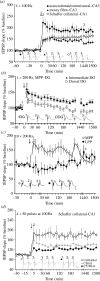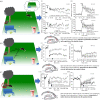Interplay of hippocampal long-term potentiation and long-term depression in enabling memory representations
- PMID: 38853558
- PMCID: PMC11343234
- DOI: 10.1098/rstb.2023.0229
Interplay of hippocampal long-term potentiation and long-term depression in enabling memory representations
Abstract
Hippocampal long-term potentiation (LTP) and long-term depression (LTD) are Hebbian forms of synaptic plasticity that are widely believed to comprise the physiological correlates of associative learning. They comprise a persistent, input-specific increase or decrease, respectively, in synaptic efficacy that, in rodents, can be followed for days and weeks in vivo. Persistent (>24 h) LTP and LTD exhibit distinct frequency-dependencies and molecular profiles in the hippocampal subfields. Moreover, causal and genetic studies in behaving rodents indicate that both LTP and LTD fulfil specific and complementary roles in the acquisition and retention of spatial memory. LTP is likely to be responsible for the generation of a record of spatial experience, which may serve as an associative schema that can be re-used to expedite or facilitate subsequent learning. In contrast, LTD may enable modification and dynamic updating of this representation, such that detailed spatial content information is included and the schema is rendered unique and distinguishable from other similar representations. Together, LTP and LTD engage in a dynamic interplay that supports the generation of complex associative memories that are resistant to generalization. This article is part of a discussion meeting issue 'Long-term potentiation: 50 years on'.
Keywords: LTD; LTP; hippocampus; learning and memory; rodent cognition; synaptic plasticity.
Conflict of interest statement
We declare we have no competing interests.
Figures




Similar articles
-
The requirement of BDNF for hippocampal synaptic plasticity is experience-dependent.Hippocampus. 2016 Jun;26(6):739-51. doi: 10.1002/hipo.22555. Epub 2016 Jan 19. Hippocampus. 2016. PMID: 26662461 Free PMC article.
-
Hippocampal long-term depression is facilitated by the acquisition and updating of memory of spatial auditory content and requires mGlu5 activation.Neuropharmacology. 2017 Mar 15;115:30-41. doi: 10.1016/j.neuropharm.2016.02.026. Epub 2016 Apr 4. Neuropharmacology. 2017. PMID: 27055771
-
Hippocampal long-term potentiation that is elicited by perforant path stimulation or that occurs in conjunction with spatial learning is tightly controlled by beta-adrenoreceptors and the locus coeruleus.Hippocampus. 2015 Nov;25(11):1285-98. doi: 10.1002/hipo.22436. Epub 2015 Apr 2. Hippocampus. 2015. PMID: 25727388 Free PMC article.
-
Hippocampal long-term depression: master or minion in declarative memory processes?Trends Neurosci. 2007 Mar;30(3):111-8. doi: 10.1016/j.tins.2007.01.002. Epub 2007 Jan 17. Trends Neurosci. 2007. PMID: 17234277 Review.
-
The Intriguing Contribution of Hippocampal Long-Term Depression to Spatial Learning and Long-Term Memory.Front Behav Neurosci. 2022 Apr 25;16:806356. doi: 10.3389/fnbeh.2022.806356. eCollection 2022. Front Behav Neurosci. 2022. PMID: 35548697 Free PMC article. Review.
Cited by
-
Cognitive Impairment and Synaptic Dysfunction in Cardiovascular Disorders: The New Frontiers of the Heart-Brain Axis.Biomedicines. 2024 Oct 18;12(10):2387. doi: 10.3390/biomedicines12102387. Biomedicines. 2024. PMID: 39457698 Free PMC article. Review.
-
Hydrogen Sulfide (H2S- or H2Sn-Polysulfides) in Synaptic Plasticity: Modulation of NMDA Receptors and Neurotransmitter Release in Learning and Memory.Int J Mol Sci. 2025 Mar 28;26(7):3131. doi: 10.3390/ijms26073131. Int J Mol Sci. 2025. PMID: 40243915 Free PMC article. Review.
-
Long-term potentiation: 50 years on: past, present and future.Philos Trans R Soc Lond B Biol Sci. 2024 Jul 29;379(1906):20230218. doi: 10.1098/rstb.2023.0218. Epub 2024 Jun 10. Philos Trans R Soc Lond B Biol Sci. 2024. PMID: 38853569 Free PMC article.
-
Ephaptic conduction molding memory engrams.BMC Biol. 2025 Jul 22;23(1):221. doi: 10.1186/s12915-025-02323-7. BMC Biol. 2025. PMID: 40696380 Free PMC article.
-
Cortico-subcortical networks that determine behavioral memory renewal are redefined by noradrenergic neuromodulation.Sci Rep. 2025 Mar 20;15(1):9692. doi: 10.1038/s41598-025-93263-3. Sci Rep. 2025. PMID: 40113948 Free PMC article.
References
-
- Manahan-Vaughan D. 2017. Learning-related hippocampal long-term potentiation and long-term depression. In Learning and memory: a comprehensive reference (second edition). reference Module in Neuroscience and Biobehavioral psychology (ed. Byrne JH), pp. 585–609. Elsevier. (10.1016/b978-0-12-809324-5.21104-8) - DOI
Publication types
MeSH terms
Grants and funding
LinkOut - more resources
Full Text Sources
Medical

